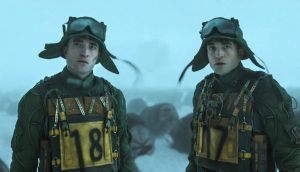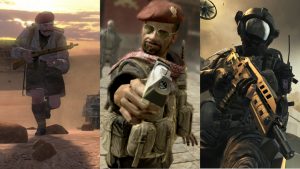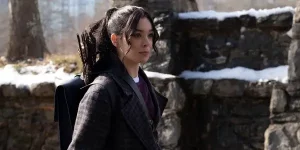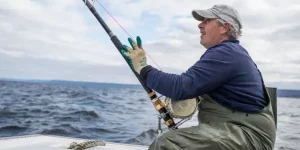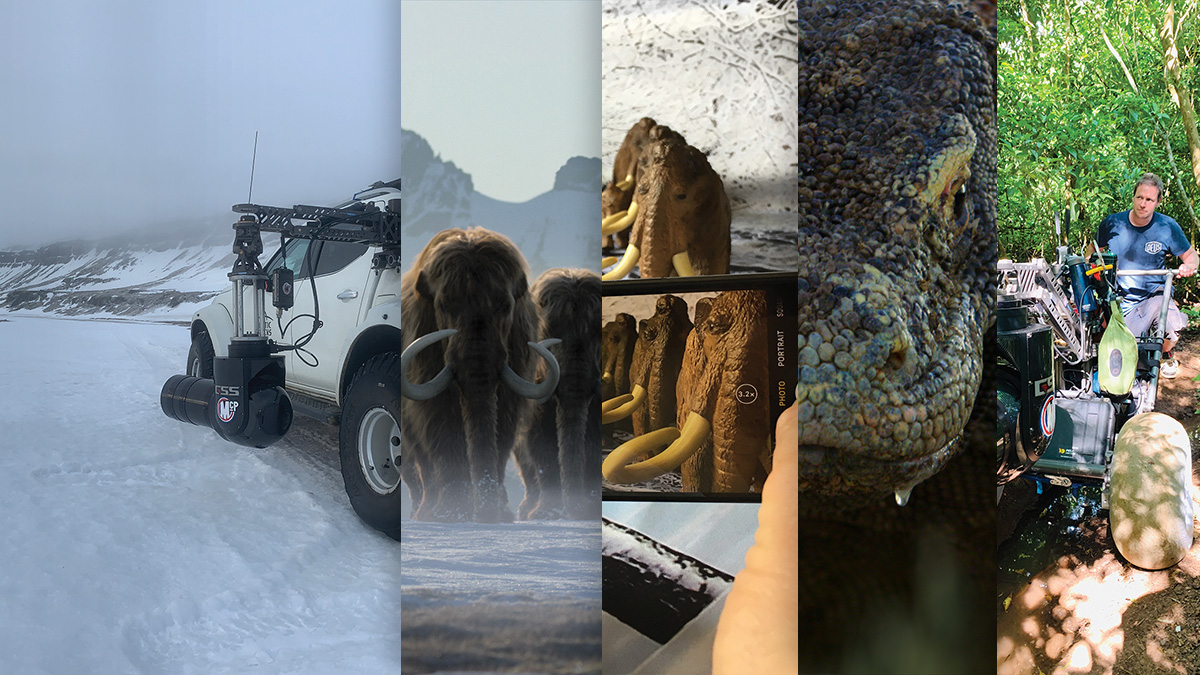
This article is presented by
“Such a weird habit that I’ve got into today,” says Dan Tapster, the showrunner for Life on Our Planet. “I’ll say, ‘Yeah, we were there to film mammoths. Yeah, people, we’re here to film a T-Rex.’”
And yet, there isn’t really a better way to describe what the team of Life on Our Planet had to do for years to create the footage that makes up the documentary series. Of course, being CGI VFX, the prehistoric stars of the series are a good deal more compliant than the stars of your average nature documentary. But it also required much more planning.
“More so than with our normal series, there was a lot more pre-production,” says Sophie Lanfear, the producer-director and writer of episodes three and eight. “This had an extended phase of research and development before we even went into the field and shot stuff. There was so much to get our heads around. Where do you even start with essentially 500 million years of complex life?”
Toy Story
First, the makers of the show needed to talk with scientists and determine how these animals would behave. “We work with Tom Fletcher, our resident paleontologist, on what the characters will look like and how they interacted,” says Jamie McPherson, director of photography for the series.
From there, the next step is “playing with dinosaur toys and Lego.” No, really.
“We use the process we call preschool pre-vis, or plastic pre-vis, which was using plastic dinosaur toys to play it out and film it with my phone and make little Lego tracking vehicles,” McPherson says.
The whole scene is created in that process and then used to make storyboards and to show ILM, Netflix, and anyone else involved in the production.
“It’s kind of the starting point that lets us see the creatures in space—and is also an excuse to buy 50 prehistoric plastic animals,” McPherson tells us.
But toys will only take you so far, and central to the making of Life on Our Planet was the use of real filming in real locations.
“It makes the VFX feel much more real in my view,” says Lanfear. “Of course, we could have had the backgrounds be CGI as well as the animals but by choosing to film real locations, the scenes became somehow more believable—I guess because they’re grounded in reality. This also helped make our VFX scenes blend in really well with our modern-day natural history ones.”
In finding those locations to film, scientific veracity was the watchword. But sometimes, the search for that veracity took the team to surprising places. For instance, an early episode features the tree fern forests where Arthropleura, the giant millipede, lived.
“We talked to the scientists, and for each scene they were like, ‘Here are the plants you can use, here are the plants you can’t use,’ and then we found this great tree fern nursery in Ireland,” says Tapster.
“This guy’s garden in Ireland, basically, where he has some of the biggest tree ferns outside of Tasmania, and I think New Zealand,” adds McPherson. “There’s a microclimate that these things can grow in. They’re over head height, the size of trees, these ferns. It’s amazing.”
While scientific veracity was always the priority, other more prosaic concerns also came into play.
“The act of getting the shot you needed also had a role in the location choice. We use Surrey in SE England for part of the T-Rex scene in part because the vegetation was correct, but, crucially, it had a car park which let us drive the camera-car around at T-Rex speeds with no wobble,” Tapster points out.
Setting the Scene
But if you are telling the tale of the entire history of life on Earth, there are times when you will need to go beyond Surrey. For instance, to show the volcanic eruptions that drew a curtain on the Permian age, a crew needed to actually camp in the environs of the erupting Icelandic volcano in 2021.
“The basalt that erupts from it, it’s very light, like meringue, but it’s really sharp meringue. So, when the wind blows, all the sharp bits of grain just get in your eyes and face. Then there’s that black dust,” recalls Lanfear. “There’s a good picture of Jamie and Ben Hardman, who is an amazing drone operator, and they look like chimney sweeps.”
Strangely enough, none of them seem to mind.
“I was in my element; the more remote it can be, the better!” Lanfear says. “We got special permission to camp [near the volcano]. At the time, it was some of the newest earth on the planet.”
“That’s such an amazing place to be,” McPherson agrees. “Camping near volcanoes is very exciting, a boyhood dream. So yeah, that didn’t seem arduous at the time because you are in one of the most amazing landscapes on earth and getting to see these volcanoes go off, which is incredible.”
However, the act of getting to the volcano at the right time was a bit more of a challenge.
“Volcanoes almost didn’t happen for us,” Tapster says. “We waited for four years for an eruption because we made Life on Our Planet during a weirdly quiet time for volcanoes. We almost thought we were going to have to use FX or library footage. Then suddenly Iceland erupted and kept erupting for weeks. Then, three months later, La Palma erupted and we were spoiled for choice!”
Fortunately, drone specialist Hardman was already on the site in Iceland, and Tapster credits him with shaping a lot of the style of the series with his aerial shots of apocalyptic wildernesses.
“He got access to the volcano and was there within about six hours of it erupting. So, he was one of the very first people that got there. And he sent us back some amazing footage,” Tapster says.
Because the eruption lasted for as long as it did, McPherson was also able to get to the site and shoot some footage of his own alongside some woolly mammoth scenes he was there to film. Filming volcanoes to stand in for prehistoric landscapes, however, brings its own challenges.
“If the lava started heading towards a grass-filled area, we can’t show that because it’s for a scene based during the Permian Era, and grass hasn’t evolved,” Tapster says.
Grass was a common problem, given that it only evolved a relatively recent 55 million years ago.
“Grass was the bane of our lives. We were picking grass out of beaches with tweezers,” Tapster recalls.McPherson agrees: “There was a lot of gardening.”
Shooting Invisible Stars
For most of the prehistoric sections of Life on Our Planet, these locations are backdrops for CGI stars. But that didn’t make the act of filming them any less involved.
“You have to work out where the [creature is] going to come from and how the scene plays out in that space,” McPherson says. “But we film them dynamically as if thereis a creature there.”
McPherson’s dynamic filming style proved integral to making Life on Our Planet feel like a nature documentary showing living creatures. “Jamie is one of the leading camera operators in natural history filmmaking. His style has been one of the most revolutionary styles, I think, probably since Planet Earth,” Lanfear tells us.
“We are trying to shoot it like a high-end natural history series,” McPherson says. “We’re moving, using tracking vehicle work quite often to make it all come to life. It’s a very exciting process.”
But where most nature photographers have animals to film, McPherson did not even have the benefit of a cardboard cut-out when shooting the prehistoric scenes, in case it gave away what they were filming.
“Often, it was a just big stick with markers for where the top of [the creature’s] head was and where its eyes were, so that we could frame it,” McPherson says. “Then you take that out, and we have people run through the frame acting the scene out in various embarrassing ways.”
He adds: “I always filmed them running, so we’ve got bloopers.”
Sometimes, however, there isn’t even a stick on set.
“For the most part when shooting VFX, we are literally filming nothing, which is a very, very odd experience,” Tapster says. “But what Jamie is really good at is going to a location and knowing what we’re trying to get in intricate detail. Then he looks at the landscape and has this inherent understanding of animal behavior. He’d say, ‘That animal is going to come out of there in that direction, and this animal is going to do this slightly differently to how we planned, but looking at the landscape, that is how it would work.’ And then we’d go filming.”
McPherson, however, is grateful to be shooting subjects who are so cooperative, even if they are imaginary.
“It’s finding the best-case scenario,” he says. “If you had a real tiger or bear coming out of the woods, where would we want to come from with the lighting to make it the most amazing shot possible?”
Live Action
Life on Our Planet is a story that stretches from the earliest microbes to the modern day and features some animals, such as sharks and, notably, dragonflies, which have been around since before the dinosaurs. For those creatures, CGI wouldn’t do, but even here, the filmmakers were looking for something different from a typical nature documentary.
“We were going to shoot what we had written in our scripts. So, in that respect, it was easier than some other natural history series because we knew exactly what we needed to shoot,” says Lanfear. “It meant we could focus on the style of the series and the visual spectacle of it.”
In shooting these animals, Life on Our Planet’s film crews achieved spectacular footage. The Komodo dragon footage, for example, draws a direct line from the present day to prehistoric jungles but also shows us things we’ve never seen before.
“There was a time in the Triassic where this is what the world looked like, dominated by giant reptiles,” Tapster says. “But we found a great bit of the story, which is, ‘If you are living in a world of giant reptiles, what the hell do you do when you’re little, a baby, a hatchling?’”
McPherson captured beautiful footage of hatchling Komodo dragons restricted to the trees while the dominant adults roamed below, as well as an epic and dramatic hunting scene.
“We had this new system with a buggy that you can push around to follow the dragons to film them moving through the forest,” McPherson explains.
Ultimately, the filming of the giant reptiles was disrupted by events that felt every bit as dramatic as the world-changing phenomena the series documents.
“We were in Indonesia when the [Covid] lockdown happened, and so we only had 10 days on location,” McPherson recalls. “So, we were very lucky that during those 10 days, we got some footage the likes of which has never been seen before.”
“When we went into lockdown, Dan and Fiona [Marsh, production manager] were like, ‘If we don’t get you home, we don’t know that you’ll even be able to get home,’” Lanfear tells us. “Imagine if they were stranded in Komodo for six months!”
As well as the Komodo dragon shoot, Covid also disrupted the crew shooting snow leopards in Nepal.
“That was so remote,” Tapster says. “They could only get comms once a week by undertaking a seven-hour round trip to the nearest village. And so, they had this weird experience of the growth of Covid.”
This team also captured one of the most dramatic and unexpected scenes of the entire series.
“Twenty years ago, I worked on a series about mammals and snow leopards were the Holy Grail; they were almost impossible to film. But more recently, there’s this one location where they had become a little bit more reliable,” Tapster explains. “But still not that reliable, which is why the shoot was so long. The team was hiking around the Himalayas for seven weeks, but eventually, they worked out where the family of mum and cubs lived and where that very old male was hunting.”
One day, they spotted the male up a mountain, hunting an ibex, and very quickly set up the camera and tripod.Tapster recounts: “They turn the camera on, and five seconds after turning it on, he did the sprint, jumped to the ibex, missed it, and fell down the cliff.”
Sadly, both snow leopard and ibex fell and died in the struggle.
“For the team, it was a real bittersweet moment because they had been tracking this guy for six weeks,” Tapster says. “But that was the behavior we were trying to get. He had become locally known for jumping at these mountain goats and rolling down the cliff with them. Yet this time, he just got the timing wrong.”
Less tragic but equally stunning is the incredible footage that Life on Our Planet has achieved swimming alongside humpback whales thanks to the latest stabilized camera systems. “Back in the day, these systems were used for helicopter filming. There are these huge gimbals that allow you to stabilize a very long 1,500-millimeter lens,” he says.
“You can shake the camera, and it just looks like it’s on rails. It doesn’t move at all.”
McPherson’s innovation was to transplant that kind of mounting onto other vehicles, from four-by-fours to snowmobiles to the buggy that filmed the Komodo dragons.
“Jamie revolutionized the way in which natural history is shot with the use of camera stabilized systems,” Tapster says.
But the whale shoot marked the first time the technique was used underwater.
“It’s basically an underwater camera gimbal that you remotely operate on the surface,” explains McPherson.
That brings its own challenges.
“It causes so much drag as soon as you put it underwater and accelerate the boat,” says Tapster. “It had to be really over-engineered to cope with the forces it was under. That took a lot of trial and quite a lot of error, but eventually, they got a system that worked.”
Life on Our Planet has done the impossible, bringing long-extinct creatures back to life, but it also gives us totally fresh perspectives on the animals with us today.
As Tapster says: “The goal for Life on Our Planet was to not only film our subjects in as dramatic way as possible, but to also use that lens to give our planet ‘context’—to let people really understand our planet and its animals like never before… and I for one think that that’s mission accomplished.”
Life On Our Planet is out now on Netflix.
The post The Filmmaking Magic Behind the Making of Netflix’s Life on Our Planet appeared first on Den of Geek.
